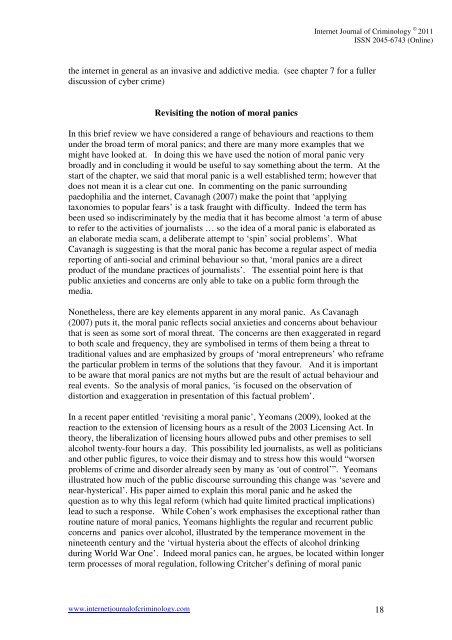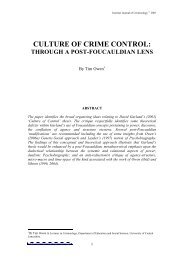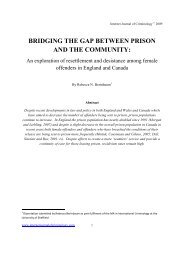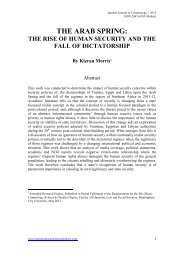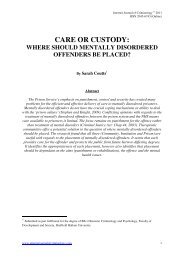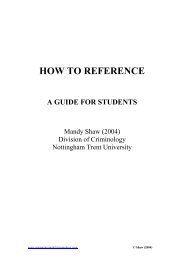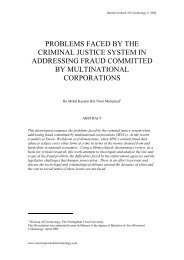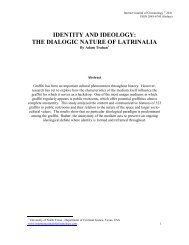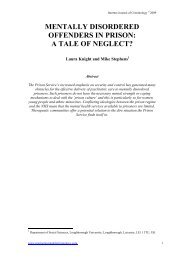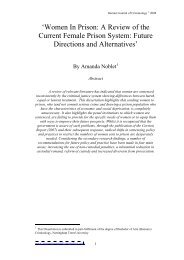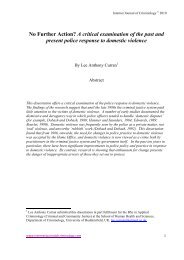moral panics and the british media - Internet Journal of Criminology
moral panics and the british media - Internet Journal of Criminology
moral panics and the british media - Internet Journal of Criminology
You also want an ePaper? Increase the reach of your titles
YUMPU automatically turns print PDFs into web optimized ePapers that Google loves.
<strong>Internet</strong> <strong>Journal</strong> <strong>of</strong> <strong>Criminology</strong> © 2011<br />
ISSN 2045-6743 (Online)<br />
<strong>the</strong> internet in general as an invasive <strong>and</strong> addictive <strong>media</strong>. (see chapter 7 for a fuller<br />
discussion <strong>of</strong> cyber crime)<br />
Revisiting <strong>the</strong> notion <strong>of</strong> <strong>moral</strong> <strong>panics</strong><br />
In this brief review we have considered a range <strong>of</strong> behaviours <strong>and</strong> reactions to <strong>the</strong>m<br />
under <strong>the</strong> broad term <strong>of</strong> <strong>moral</strong> <strong>panics</strong>; <strong>and</strong> <strong>the</strong>re are many more examples that we<br />
might have looked at. In doing this we have used <strong>the</strong> notion <strong>of</strong> <strong>moral</strong> panic very<br />
broadly <strong>and</strong> in concluding it would be useful to say something about <strong>the</strong> term. At <strong>the</strong><br />
start <strong>of</strong> <strong>the</strong> chapter, we said that <strong>moral</strong> panic is a well established term; however that<br />
does not mean it is a clear cut one. In commenting on <strong>the</strong> panic surrounding<br />
paedophilia <strong>and</strong> <strong>the</strong> internet, Cavanagh (2007) make <strong>the</strong> point that ‘applying<br />
taxonomies to popular fears’ is a task fraught with difficulty. Indeed <strong>the</strong> term has<br />
been used so indiscriminately by <strong>the</strong> <strong>media</strong> that it has become almost ‘a term <strong>of</strong> abuse<br />
to refer to <strong>the</strong> activities <strong>of</strong> journalists … so <strong>the</strong> idea <strong>of</strong> a <strong>moral</strong> panic is elaborated as<br />
an elaborate <strong>media</strong> scam, a deliberate attempt to ‘spin’ social problems’. What<br />
Cavanagh is suggesting is that <strong>the</strong> <strong>moral</strong> panic has become a regular aspect <strong>of</strong> <strong>media</strong><br />
reporting <strong>of</strong> anti-social <strong>and</strong> criminal behaviour so that, ‘<strong>moral</strong> <strong>panics</strong> are a direct<br />
product <strong>of</strong> <strong>the</strong> mundane practices <strong>of</strong> journalists’. The essential point here is that<br />
public anxieties <strong>and</strong> concerns are only able to take on a public form through <strong>the</strong><br />
<strong>media</strong>.<br />
None<strong>the</strong>less, <strong>the</strong>re are key elements apparent in any <strong>moral</strong> panic. As Cavanagh<br />
(2007) puts it, <strong>the</strong> <strong>moral</strong> panic reflects social anxieties <strong>and</strong> concerns about behaviour<br />
that is seen as some sort <strong>of</strong> <strong>moral</strong> threat. The concerns are <strong>the</strong>n exaggerated in regard<br />
to both scale <strong>and</strong> frequency, <strong>the</strong>y are symbolised in terms <strong>of</strong> <strong>the</strong>m being a threat to<br />
traditional values <strong>and</strong> are emphasized by groups <strong>of</strong> ‘<strong>moral</strong> entrepreneurs’ who reframe<br />
<strong>the</strong> particular problem in terms <strong>of</strong> <strong>the</strong> solutions that <strong>the</strong>y favour. And it is important<br />
to be aware that <strong>moral</strong> <strong>panics</strong> are not myths but are <strong>the</strong> result <strong>of</strong> actual behaviour <strong>and</strong><br />
real events. So <strong>the</strong> analysis <strong>of</strong> <strong>moral</strong> <strong>panics</strong>, ‘is focused on <strong>the</strong> observation <strong>of</strong><br />
distortion <strong>and</strong> exaggeration in presentation <strong>of</strong> this factual problem’.<br />
In a recent paper entitled ‘revisiting a <strong>moral</strong> panic’, Yeomans (2009), looked at <strong>the</strong><br />
reaction to <strong>the</strong> extension <strong>of</strong> licensing hours as a result <strong>of</strong> <strong>the</strong> 2003 Licensing Act. In<br />
<strong>the</strong>ory, <strong>the</strong> liberalization <strong>of</strong> licensing hours allowed pubs <strong>and</strong> o<strong>the</strong>r premises to sell<br />
alcohol twenty-four hours a day. This possibility led journalists, as well as politicians<br />
<strong>and</strong> o<strong>the</strong>r public figures, to voice <strong>the</strong>ir dismay <strong>and</strong> to stress how this would “worsen<br />
problems <strong>of</strong> crime <strong>and</strong> disorder already seen by many as ‘out <strong>of</strong> control’”. Yeomans<br />
illustrated how much <strong>of</strong> <strong>the</strong> public discourse surrounding this change was ‘severe <strong>and</strong><br />
near-hysterical’. His paper aimed to explain this <strong>moral</strong> panic <strong>and</strong> he asked <strong>the</strong><br />
question as to why this legal reform (which had quite limited practical implications)<br />
lead to such a response. While Cohen’s work emphasises <strong>the</strong> exceptional ra<strong>the</strong>r than<br />
routine nature <strong>of</strong> <strong>moral</strong> <strong>panics</strong>, Yeomans highlights <strong>the</strong> regular <strong>and</strong> recurrent public<br />
concerns <strong>and</strong> <strong>panics</strong> over alcohol, illustrated by <strong>the</strong> temperance movement in <strong>the</strong><br />
nineteenth century <strong>and</strong> <strong>the</strong> ‘virtual hysteria about <strong>the</strong> effects <strong>of</strong> alcohol drinking<br />
during World War One’. Indeed <strong>moral</strong> <strong>panics</strong> can, he argues, be located within longer<br />
term processes <strong>of</strong> <strong>moral</strong> regulation, following Critcher’s defining <strong>of</strong> <strong>moral</strong> panic<br />
www.internetjournal<strong>of</strong>criminology.com 18


